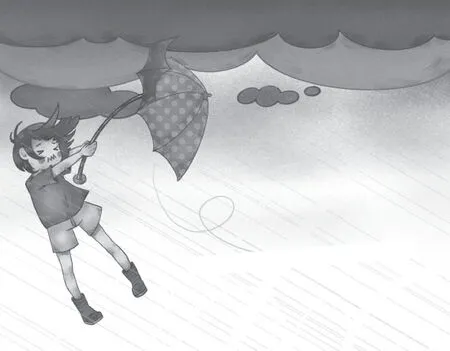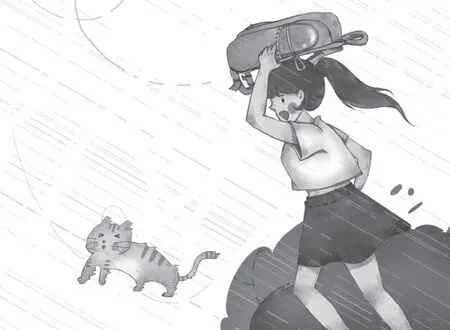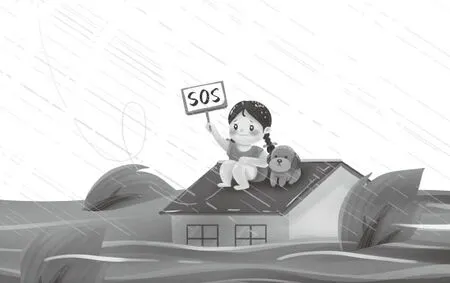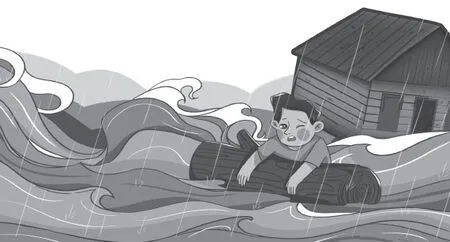Understanding and Protecting Against Severe Convective Weather
◎Juno
强对流天气是发生突然、破坏性极大的灾害性天气,常伴有雷雨、大风、冰雹、龙卷风、局部强降雨等。除了待在家,还有哪些防范强对流天气的个人保护策略呢?一起阅读下文了解下吧!

Severe convective weather,characterized by thunderstorms,heavy rain,lightning,1)hail,and high winds,poses significant risks to both life and property.Understanding these2)phenomenaand how to protect ourselves can mitigate many of the dangers associated with such extreme weather events.
The effects of severe convective weather
1.Gale: High winds can topple trees,rip roofs from structures,and hurl debris at high velocities,causing extensive damage to homes and infrastructure.
2.Heavy rain: Short time heavy rainfall can lead to rapid flooding,endangering communities especially in low-lying areas.Flash floods,the most dangerous kind of floods,can occur within minutes after a heavy downpour,turning streets into rivers and sweeping away cars,soil,and vegetation.
3.Lightning strikes: Lightning is a major hazard that kills an average of 49 people each year in the United States alone.It can cause severe injuries,fatalities,and ignite3)devastating fires.
4.Hail: Hail can decimate crops in minutes,significantly affecting agricultural productivity and 4)livelihoods.In addition,hail can also damage buildings and vehicles.
Individual protection strategies
Protecting ourselves from the impacts of severe convective weather involves several proactive and reactive strategies.
1.Stay informed: The first line of defense is to stay informed about the weather conditions.Use weather Apps,subscribe to local weather alerts,and follow reliable meteorological sources to receive updates about potential severe weather.

2.Understand warning signals for meteorological hazards:Know the difference between a weather “blue alert”“yellow alert”“orange alert” and “red alert”.Take immediate precautions when a“red alert” is issued.
3.Emergency preparedness kit: Prepare an emergency kit that includes non-perishable food,water,flashlights,a first aid kit,medications,and important documents.Make sure your emergency kit is easily accessible and ready to go in case you need to evacuate quickly.
4.Safety protocols during storms: During a storm,stay indoors and away from windows,doors,and metal pipes.Do not use electrical appliances or landline phones.If you are caught outside,avoid high ground,water,and tall,isolated trees.
5.Post-storm safety: After a storm,watch out for downed power lines and damaged buildings.Do not drive through flooded roadways as floods can be deeper than they seem and fastmoving water can carry away most vehicles.
Severe convective weather demands respect and preparedness.By understanding the impacts and adopting comprehensive protection strategies,individuals can safeguard their lives and property.Remember,the best protection is prevention and preparedness.By staying informed and ready,you can significantly reduce the risks posed by these powerful natural phenomena.
1) hailn.冰雹
2) phenomenonn.现象
3) devastatingadj.毁灭性的
4) livelihoodn.生计
强对流天气,以雷暴、大雨、闪电、冰雹和大风为特征,对生命和财产造成了重大威胁。了解这些现象以及知晓如何保护自己可以减少与此类极端天气事件相关的许多危险。
强对流天气的危害
1.大风:大风可以推倒树木,掀掉建筑物的屋顶,卷起碎片并快速抛向空中,对家庭和基础设施造成大面积破坏。
2.强降水:短时强降雨可能导致洪涝灾害,危及低洼地区的社区。山洪是最危险的洪水类型,可能在大暴雨几分钟内发生,将街道变成河流,冲走汽车、土壤和植被。
3.雷电:雷电是一重大危害,仅在美国平均每年就有49 人死于雷电。它可以造成严重的伤害以及死亡,并引发毁灭性火灾。
4.冰雹:冰雹可以在几分钟内摧毁农作物,严重影响农业生产和农民生计。此外,冰雹还会损害建筑物和车辆。

个人保护策略
保护自己免受强对流天气的影响涉及一些主动和被动的策略:
1.保持信息更新:防御的第一道防线是了解天气状况。使用天气应用程序,订阅本地天气预警提醒,关注可靠的气象资源,以接收潜在的恶劣天气的更新信息。
2.了解气象灾害预警信号:了解“蓝色预警”“黄色预警”“橙色预警”和“红色预警”的区别。当发布“红色预警”信号时,我们应立即采取预防措施。
3.准备应急包:准备一个应急包,包括不易腐烂的食品、水、手电筒、急救包、药物和重要文件。确保你的应急包易于获取,并且在需要快速疏散时随时准备就绪。
4.暴风雨期间的安全:在暴风雨期间,应留在室内,远离窗户、门和金属管道。不要使用电器或座机电话。如果你被困在外面,避免待在高地、水域附近和孤立的大树下。
5.暴风雨过后的安全:暴风雨过后,注意观察是否有倒下的电线和受损的建筑物。不要驾车穿越被水淹没的道路,因为水可能比看上去的更深,快速流动的水会冲走大多数车辆。
强对流天气需要重视和做好准备。通过了解强对流天气的影响并采取全面的保护策略,个人可以保障自身生命和财产安全。记住,最好的防护措施是预防和准备。通过保持信息更新和提前做好准备,你可以显著地减少这些强大自然现象带来的风险。


